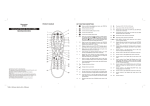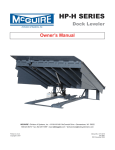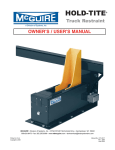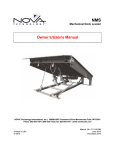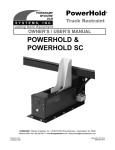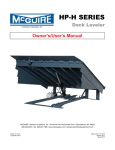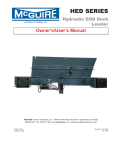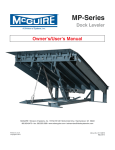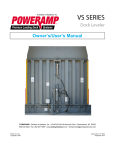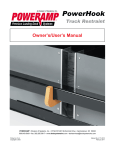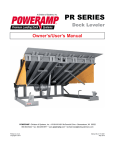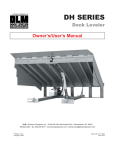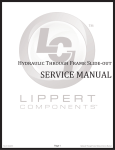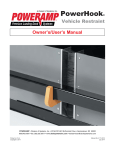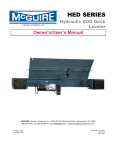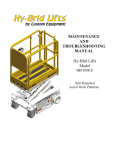Download NHS Dock Leveler Manual
Transcript
NHS Dock Leveler Owner’s Manual Nova Technology International, LLC N90 W14507 Commerce Drive Menomonee Falls, WI 53051 800-236-7325 Fax 262-502-1511 Www.novalocks.com ©Copyright 2010 Manual No. 4111-0018 Nov 2009 June 2010 Table of Contents Page 4111-0018 — Nov. 2009 June 2010 SAFETY Recognize Safety Information General Operational Safety Precautions Safety-Alert Symbol The Safety-Alert Symbol identifies important safety messages on equipment, safety signs, in manuals, or elsewhere. When you see this symbol, be alert to the possibility of personal injury or death. Follow the instructions in the safety message. The use of the word DANGER signifies the presence of an extreme hazard or unsafe practice which will most likely result in severe injury or death. The use of the word WARNING signifies the presence of a serious hazard or unsafe practice which may result in serious injury or death. The use of the word CAUTION signifies possible hazard or unsafe practice which could result in personal injury. IMPORTANT The use of the word IMPORTANT is to draw attention to a procedure that needs to be followed to prevent machine damage. Read and understand the operating instructions and become thoroughly familiar with the equipment and its controls before operating the dock leveler. Never operate a dock leveler while a safety device or guard is removed or disconnected. Never remove DANGER, WARNING, or CAUTION signs or decals on the equipment unless replacing them. er Op ng ati Zo ne a er Op ne Zo g tin Do not start the equipment until all unauthorized personnel in the area have been warned and have moved outside the operating zone. Remove any tools or foreign objects from the operating zone before starting. Keep the operating zone free of obstacles that could cause a person to trip or fall. 4111-0018 — Nov. 2009 June 2010 1 SAFETY Operational Safety Precautions Learn the safe way to operate this equipment. Read and understand the manufacturer's instructions. If you have any questions, ask your supervisor. Stay clear of dock leveling device when freight carrier is entering or leaving area. Chock/restrain all freight carriers. Never remove the wheel chocks until loading or unloading is finished and truck driver has been given permission to drive away. Do not move or use the dock leveling device if anyone is under or in front of it. Do not use a broken or damaged dock leveling device. Make sure proper service and maintenance procedures have been performed before using. Keep hands and feet clear of pinch points. Avoid putting any part of your body near moving parts. Make sure lip overlaps onto trailer at least 4 in. (102 mm). Keep a safe distance from both side edges. 2 4111-0018 — Nov. 2009 June 2010 SAFETY Do not use dock leveling device if freight carrier is too high or too low. Do not overload the dock leveling device. Do not operate any equipment while under the influence of alcohol or drugs. Do not leave equipment or material unattended on dock leveling device. 4111-0018 — Nov. 2009 June 2010 3 SAFETY Maintenance Safety Precautions ALWAYS disconnect electrical power source and ground wire before welding on dock leveler. DO NOT ground welding equipment to any hydraulic or electrical components of the dock leveler. Always ground to the dock leveler frame. Hydraulic and electrical power must be OFF when servicing the equipment. For maximum protection, use an OSHA approved locking device to lock out all power sources. Only the person servicing the equipment should have the key to unlock the device. Failure to follow these instructions may result in damage to dock leveler and/or serious personal injury or death. DO NOT grind or weld if hydraulic fluid or other flammable liquid is present on the surface to be ground or welded. DO NOT grind or weld if uncontained hydraulic fluid or other flammable liquid is present. Stray sparks can ignite spills or leaks near the work area. Always post safety warnings and barricade the work area at dock level and ground level to prevent unauthorized use of the unit before maintenance is complete. Always clean up the oil leaks and spills before proceeding with grinding or welding. Always keep a fire extinguisher of the proper type nearby when grinding or welding. Failure to follow these instructions may result in serious personal injury or death. The maintenance prop must be in the upright "service" position when working under the dock leveler. For maximum protection, use an OSHA approved locking device to lock the maintenance prop in the service position. Only the person servicing the equipment should have the key to unlock the device. 4 ALWAYS stand clear of dock leveler lip when working in front of the dock leveler. Failure to do this may result in serious personal injury or death. 4111-0018 — Nov. 2009 June 2010 SAFETY Safety Decals Every 90 days (quarterly) inspect all safety labels and tags to ensure they are on the dock leveler and are easily legible. If any are missing or require replacement, please call NOVA for replacements. 4111-0018 — Nov. 2009 June 2010 5 OWNER’S/USER’S RESPONSIBILITIES 1. The owner/ user should recognize the inherent dangers of the interface between the loading dock and the transportation vehicle. The owner/ user should, therefore, train and instruct all operators in the safe operation and use of the loading dock equipment in accordance with manufacturer’s recommendations and industry standards. Before operation of the equipment, all operators shall read, understand and be familiar with all functions of equipment as described in the owner’s/user’s manual. 2. The manufacturer shall provide to the initial purchaser all necessary information with regards to: Safety Information, Operation, Installation and Safety Precautions, Recommended Initial and Periodic Inspections Procedures, Planned Maintenance Schedule, Product Specifications, Troubleshooting Guide, Parts Break Down, Warranty Information and Manufacturers Contact Information. The owner/ user shall be responsible to verify that this information is available and received as well as proper instructions, training and familiarity of the equipment for all operators has been completed. Owner’s/ User’s shall actively maintain, update and re train all operators on safe working habits and operations of the equipment. 3. It is recommended when the transportation vehicle is positioned correctly in the dock opening and in contact with both bumpers, there shall be a minimum of 4.00 inches (100mm) overlap of the leveling device and the transportation vehicle at all times during the loading and unloading process. 4. Name plates, placards, decals, instructions and posted warnings shall not be obscured from the view of the operator or maintenance personnel for whom such warnings are intended for. Contact manufacturer for any replacements. 5. Manufacturer’s recommended periodic maintenance and inspection procedures in effect at the date of shipment shall be followed at all times. Written documentation of maintenance, replacement parts or damage should be retained. In the event of damage notification to the manufacturer is requested. 6. Any modifications or alterations of loading dock equipment shall only be done with prior written approval from the original equipment manufacturer. 7. When industrial moving devices are being used in the loading or unloading of product from the transportation vehicle, this vehicle shall have the brakes and wheel chocks applied appropriately or all other positive restraining device shall be fully utilized. 8. Loading dock safety equipment should never be used outside of its intended use, range, or capacity. Please consult the manufacturer if you have any questions as to the use, range or capacity of the equipment. 9. When selecting loading dock safety equipment, it is important to consider not only present requirements but also future plans and any possible adverse conditions, environments or use. 6 4111-0018 — Nov. 2009 June 2010 NOTES 4111-0018 — Nov. 2009 June 2010 7 INTRODUCTION General Information Dock Leveler Stock Specifications NHS dock levelers are available in the following sizes, weight capacities, and options: Width: NHS 6 ft (1828.8 mm) 6-1/2 ft (1981.2 mm) 7 ft (2133.6 mm) Length 6 ft (1828.8 mm) 8 ft (2438 mm) 10 ft (3048 mm) 12 ft (3658 mm) Congratulations on your choice of a NOVA dock leveler. This manual covers the NHS series hydraulic dock leveler. Designed to be a marvel of simplicity and efficiency, your dock leveler, when properly installed, will provide many years of trouble-free performance with an absolute minimum of maintenance. Its revolutionary hydraulic system efficiently controls and operates every function. To obtain maximum performance and longest possible use, a simple program of preventive maintenance is recommended. Capacity (CIR*) 25,000 lb (11 340 kg) 30,000 lb (13 608 kg) 35,000 lb (15 876 kg) 40,000 lb (18 144 kg) 45,000 lb (20 412 kg) 55,000 lb (24 948 kg) 75,000 lb (34 019 kg) 100,000 lb (45 359 kg) * CIR (Comparative Industry Rating) Call NOVA to discuss available voltages, phases and options to meet your specific needs. The NHS series dock leveler comes equipped with an electrical control panel, which allows pushbutton operation of the dock leveler functions. Each NHS dock leveler unit and control panel has been factory prewired and tested to ensure satisfactory operation. To illustrate which connections are to be made in the field at installation, electrical drawings are included with each order or by contacting NOVA Technical Services. Once again, thank you and congratulations on your purchase of a NOVA hydraulic dock leveler. 8 4111-0018 — Nov. 2009 June 2010 INTRODUCTION Component Identification THEORY The NHS dock leveler uses hydraulics and one-button operation for ease of use. Platform (B) is raised by pushing and holding the RAISE button (K). This activates an electric motor (D) which, in turn, drives a hydraulic pump. The hydraulic pump forces oil into the platform cylinder(s) (F),causing the platform to rise. Releasing the RAISE button allows the platform to lower. 4111-0018 — Nov. 2009 June 2010 K 9 INSTALLATION Prepare Pit C A 10” 14 B D A—Distance (Pit Width) (Front and Rear) B— Distance (Dock Floor-to-Pit Floor) (All Four Corners) C— Distance (Pit Length) (Both Sides of Pit) D— Distance (Pit Corner-to-Corner) (Top, Bottom and Both Sides) Before lowering the dock leveler into the pit, the following must be performed: Post safety warnings and barricade the work area at dock level and ground level to prevent unauthorized use of the dock leveler before installation has been completed. Failure to follow the installation instructions can result in damage to dock leveler, the facilities, and/or serious personal injury or death. Only trained installation professionals with the proper equipment should install this product. IMPORTANT DO NOT remove the shipping bands around the dock leveler lip until instructed to do so. 1. Remove all debris from the pit and sweep the pit clean. 2. Check the entire dock leveler pit for proper construction according to approved/certified pit drawings. Make sure pit is square by making the following measurements: • Measure pit width distance (A) at both front and rear of pit. • Measure dock floor-to-pit floor distance (B) at all four corners. • Measure pit length distance (C) at both sides. • Measure corner-to-corner (criss-cross) distance (D) at both sides. Take measurements at dock floor level and at pit floor level. If any measurement is off by more than 1/8 in. (3.18 mm), contact NOVA Technical Services before proceeding. 3. Make sure the field junction box for the dock leveler (E) is at the correct location per pit diagrams. 10 4111-0018 — Nov. 2009 June 2010 INSTALLATION IMPORTANT A DO NOT remove the shipping bands (B) around the platform lip and leveler frame at this time. The shipping bands are needed to hold the leveler together during the installation process. Turn to page 15 for front pick up. 1. Remove any control panel and bumpers that may be banded to the frame of the dock leveler. DO NOT remove the shipping bands (B) around the platform lip and leveler frame at this time. B A— Lifting Bracket (2 used) B — Shipping Bands NOVA dock levelers are designed with installation in mind. Each unit is shipped with lifting brackets (A) fastened to the platform side joists. A third sling may be used to install the unit. The dock leveler is heavy. Use a lifting device andchains with the appropriate lifting capacity and reach. Always use the lifting brackets provided with the unit whenever lowering or lifting a dock leveler into or out of a pit. Failure to follow these instructions may result in damage to dock leveler and/or serious personal injury or death. 4111-0018 — Nov. 2009 June 2010 IMPORTANT DO NOT overtighten the lifting bracket hardware. Overtightening can damage the weather seal, if equipped. NOTE: Overall width of platform and lifting brackets (A) must be kept to a minimum to prevent interference between the lifting brackets and the pit walls as the dock leveler is lowered into the pit. 2. Make sure the mounting hardware of lifting brackets (A) is snug. The brackets should pivot relatively freely on the mounting cap screw. DO NOT overtighten. 3. Attach lifting chains to lifting brackets (A) and to a lifting device (i.e., hoist or fork truck) having the appropriate lifting capacity and reach. 4. Remove shipping pallet, if present, before putting the dock leveler into the pit. 11 INSTALLATION 12 4111-0018 — Nov. 2009 June 2010 INSTALLATION NOTE: NOVA dock levelers are designed with a nominal 1/2 in. (12.7 mm) shimming distance to allow for pit inconsistencies. 1. Determine height of shim stack (K) for each shim location (B) by performing the following: a. Measure leveler frame height distance (A). b. Measure dock floor-to-pit floor distance (H) at each shim location (B). Write down the dimensions obtained at each location. c. Subtract distance (A) from distance (H) to obtain the shim height. Repeat for each shim location. IMPORTANT The minimum size of the shim that contacts the leveler frame (i.e., the top shim of each shim stack) must be at least 4-1/2 x 4-1/2 in. (114.3 x 114.3 mm) to support the full width of the frame rail and to provide a shelf for a fillet weld. Use the thickest shim stock possible for stability and weld penetration purposes. DO NOT use multiple layers of 1/8 in. (3.18 mm) or thinner shim stock. 2. Using the results obtained in step 1, create the individual shim stacks on the pit floor at locations (B). Build each shim stack (K) using the pyramid method (M) (preferred) or stepped method (N) with the top shim having a minimum size of 4-1/2 x 4-1/2 in. (114.3 x 114.3 mm) and each successive lower shim being larger so the shims can be welded together using a fillet weld. DO NOT use offset method (P) or straight method (Q). 4. For all NHS models, put a minimum 1/4 in. (6.6 mm) thick shim at locations (B and C). NOTE: A 1/4 in. (6.6 mm) thick shim at locations (B and C) is used only as a starting point. The final shim stack height will be determined after dock leveler is lowered into the pit. The dock leveler is heavy. Use chains and a lifting device with the appropriate lifting capacity and reach. Failure to do so may result in damage to dock leveler and/or serious personal injury or death. 5. Using an appropriate lifting device connected to the lifting brackets, lower dock leveler into the pit so rear hinge frame angle (G) is tight against rear pit curb angle (E) across full width of the leveler frame. 6. Allow rear of dock leveler to rest on the rear shims while keeping the front of the dock leveler level with the dock floor. 7. For all NHS models, add shims at front shim locations (C) so front of dock leveler will stay Level with dock floor when leveler is resting fully on shims. NOTE: To assist in obtaining an accurate measurement of distance (J), use a string (F) pulled tight across the pit opening, directly over the shim locations. 3. Verify that each shim stack is at the correct height by measuring distance (J) [top of shim stack (K) to dock floor]. Distance (J) must equal the dock leveler height (A). 4111-0018 — Nov. 2009 June 2010 13 INSTALLATION 8. With rear hinge frame angle (F) tight against rear pit curb angle (G), perform/check the following: • Pry between the platform and rear hinge frame angle at locations (E) to make sure rear edge of platform is parallel to the rear hinge frame angle (F). • Gap (D) must exist equally along both sides of leveler so weather seal (if equipped) will not bind during dock leveler operation. 14 9. If gap (D) cannot be obtained equally at both sides of leveler, grind or add material at the rear edge of rear hinge frame angle (F) as needed. 10. Allow the dock leveler to rest fully on the shim stacks. Check that a smooth and level transition exists between the dock floor and the dock leveler platform. Add or remove shims as necessary until a smooth transition is obtained. 11. If leveler cannot be squared and/or made level as instructed in steps 8 — 10, contact NOVA Technical Services. 4111-0018 — Nov. 2009 June 2010 INSTALLATION IMPORTANT DO NOT grind or weld if hydraulic fluid or other flammable liquid is present on the surface to be ground or welded. DO NOT grind or weld if uncontained hydraulic fluid or other flammable liquid is present. Stray sparks can ignite spills or leaks near the work area. Always clean up the oil leaks and spills before proceeding with grinding or welding. Always keep a fire extinguisher of the proper type nearby when grinding or welding. Failure to follow these instructions may result in serious personal injury or death. IMPORTANT DO NOT connect the dock leveler electrical wiring and ground connections until all welding has been completed. DO NOT ground welding equipment to any hydraulic or electrical components of the dock leveler. Always ground welding equipment to the dock leveler frame, NEVER to the platform. Failure to follow these instructions may damage the motor, hoist cylinder, wiring, and/or control panel. NOTE: The illustration on the previous page shows a typical weld pattern. The weld pattern will vary slightly depending on size of dock leveler. 4111-0018 — Nov. 2009 June 2010 DO NOT weld continuously along the full length of the rear hinge frame angle. This can put unnecessary stress on the leveler components, causing the leveler to malfunction and shorten the lifespan of the affected components. 11. With the rear hinge frame angle (F) tight against the rear pit curb angle (G), weld the rear hinge frame angle (F) to the rear pit curb angle (G) using a 3/8 in. (9.5 mm) flare bevel skip weld — each weld being 6 in. (152 mm) long. Start at each end with a 6 in. (152 mm) long weld. Space all the other welds out evenly leaving approximately 6 in. (152 mm) space between each weld. 12. Weld front of dock leveler frame (B) to shims located under the keepers, then weld the shims to the front pit curb steel. 13. With leveler welded into place, remove the shipping bands from around lip and leveler frame. If the platform is raised using an external lifting device or the hydraulic system is opened to atmosphere, air will enter into the hydraulic system. Whenever this happens, always cycle the leveler at least 4 times using the leveler’s own hydraulic power system before allowing the leveler to be put into service. This is to make sure all air is purged from the hydraulic cylinders. Failure to do this may result in serious personal injury or death. 15 INSTALLATION 14. Using an external lifting device (i.e., crane or fork truck) attached to the platform lifting brackets, slowly raise the platform. Check for binding as platform is being raised. 15. If binding occurs, lower the platform. Reposition leveler and/or add or remove shims as necessary. Slowly raise platform again. If platform still binds, contact NOVA Technical Services for further instructions. 16. All NHS models: a. Install shims under maintenance prop (B) where prop attaches to leveler frame. Make sure prop is solidly shimmed. b. Using the appropriate lifting device, attached to the platform lifting lugs, slowly raise the dock to the fully open position. c. Raise maintenance prop (B) to the service (upright) position and lock prop in this position using an OSHA approved locking device. (Supplied by others.) 16 Two people are required to engage the maintenance prop: one person to operate the lifting device, the other person to engage the maintenance prop. DO NOT use the maintenance prop to support the raised platform until the maintenance prop has been properly shimmed and welded. The shims must be welded to each other, the leveler frame, and to the front pit curb steel. Failure to do this may result in serious personal injury or death. d. Proceed to step 18. 4111-0018 — Nov. 2009 June 2010 INSTALLATION Make sure the platform is properly supported in the raised position before entering the pit to finish weld the shims. Failure to do this may result in serious personal injury or death. 18. All model levelers: Install shims at locations (B)(C) (Ref.page 10) using the pyramid or stepped shimming method. Both platform cylinder trunnions must be solidly shimmed the entire length of the trunnion. Make sure the trunnions are level from side-to-side as well as from front-to-back. 19. Finish weld all shims using a fillet weld. • Weld all shims within each shim stack to each other, then weld the shim stack to the leveler frame. • Weld the front leveler frame shim stacks to the front pit curb steel. 20. When all welding has been completed, paint all the welds and shims. NOTE: To pick up unit from the front, move forks closer together and slide over the frame and under the cross member. It may be necessary to unband the unit to gain access to the front, by lifting the lip up then sliding the forks under the cross member. (Ref: page 9) 4111-0018 — Nov. 2009 June 2010 17 INSTALLATION Install Control Panel and Wiring The electrical power must be OFF prior to electrical installation. For maximum protection, use an OSHA approved locking device to lock out all power sources. Only the person installing the equipment should have the key to unlock the power source. Failure to follow these instructions may result in serious personal injury or death. DO NOT make any final electrical connections until all welding has been completed. Failure to do this may result in serious personal injury or death. All electrical work — including the installation of the disconnect panel, control panel, and final connections to the pit junction box — must be performed by a certified electrician and conform to all local and applicable national codes. 1. Mount the pushbutton control panel (B) so bottom of control panel-to-dock floor distance (C) is a minimum 48 in. (1219.2 mm). 2. Install electrical disconnect panel (A) if not already installed. 3. Install and connect the control wiring. 4. Connect the dock leveler power cable to the field wires in the pit junction box. Refer to the electrical drawings supplied with the dock leveler. 5. After all electrical connections in the pit have been made, disengage the maintenance prop and lower the platform using the external lifting device connected to the platform lifting brackets. 18 4111-0018 — Nov. 2009 June 2010 INSTALLATION Put New Dock Leveler Into Service 1. Disconnect the external lifting device and chains from the lifting brackets. 2. Check that the leveler is flush with the dock floor and that the platform lip contacts both lip keepers evenly. If an excessive transition exists between the dock floor and leveler and/or lip does not contact Both lip keepers evenly, contact NOVA Technical Services for further instructions. 3. Install the dock bumpers as required. 4. Turn the main electrical power ON. Always stand clear of platform lip when working in front of the dock leveler. Serious personal injury or death may result. 5. Raise the leveler platform fully by pushing and holding the RAISE button . NOTE: The platform of a properly operating dock leveler will automatically stop rising when it reaches its full raised height, at which point, the lip extends. (If the lip does not extend or extend fully, see Platform Rises to Full Height, But Lip Does Not Fully Extend in the Troubleshooting section.) 6. Release the RAISE button to lower the platform. As long as there is no truck present at the dock, the platform will lower to the full below-dock position with the lip extended. NOTE: If a truck is present, the platform will lower until the lip rests on the truck/trailer bed. (See Operating Instructions in Operation section.) 4111-0018 — Nov. 2009 June 2010 7. When the platform lowers to the full below-dock position, push and hold the RAISE button until the lip retracts and platform rises just enough to have the lip clear the lip keepers, then release the RAISE button to allow the platform to lower to the cross-traffic (stored) position (lip engages lip keepers). NOTE: For dock levelers equipped with Auto Return To Dock (ARTD), the platform will automatically return to the cross-traffic position if the ARTD is in NORMAL mode. When the platform is about 1.00 inch from the full below-dock position, the platform will automatically rise to the cross-traffic position. (See below dock servicing and end loading for additional instructions) 8. Perform steps 5 – 7 at least four times to purge any air that may be in the hydraulic system and to ensure proper operation. Unless the dock leveler is equipped with a tethered remote, two people are required to engage the maintenance prop: one person to operate the unit, the other person to engage the maintenance prop. 9. Raise the platform fully. Hold the platform at this position using the RAISE button and move the maintenance prop to the service (upright) position. Release the RAISE button to allow the platform to lower until it is resting on the maintenance prop. 10.With the maintenance prop supporting the platform, remove the lifting brackets on both sides of the unit. 11.Push and hold the RAISE button until the maintenance prop drops to its stored position. Release the RAISE button and allow the platform to lower fully. 12.Perform step 7 if not equipped with ARTD. 19 OPERATION Stay clear of dock leveler when freight carrier is entering or leaving dock area. DO NOT move or use the dock leveler if anyone is under or in front of leveler. Keep hands and feet clear of pinch points. Avoid putting any part of your body near moving parts. Failure to follow these instructions may result in severe personal injury or death. Only trained personnel should operate the dock leveler. DO NOT use a broken or damaged dock leveler. Make sure proper service and maintenance procedures have been performed on leveler before using. Truck/trailer wheels must be chocked unless the truck restraint is used. Never remove the wheel chocks until loading/unloading is finished and truck driver has been given permission to leave. Make sure platform lip rests on the truck/trailer bed with at least 4 in. (102 mm) of overlap. The NHS hydraulic dock leveler is designed to compensate for a maximum ± 12 in.* (305 mm) of height difference between the loading dock and the truck bed. DO NOT use the dock leveler if the truck/trailer bed is more than 12 in. (305 mm) higher or lower than the dock floor. *service height may vary with design specifications DO NOT overload the dock leveler. DO NOT operate any equipment while under the influence of alcohol or drugs. DO NOT leave equipment or material unattended on the dock leveler. Failure to follow these instructions may result in personal injury and/or damage to equipment. Maintain a safe distance from side edges of leveler during the loading/unloading process. Failure to follow these instructions may result in serious personal injury or death. 20 4111-0018 — Nov. 2009 June 2010 OPERATION Operating Instructions—Continued Ramp Loading/Unloading Instructions NOTE: If end unloading is required, see End Loading/Unloading Instructions on page 20. For ramp loading or unloading, the NHS dock leveler can be operated by using the RAISE button on the control panel. 1. Check to make sure truck/trailer is positioned squarely against dock bumpers. 2. Instruct driver to remain at the dock until the loading or unloading process has been completed. 5. Proceed with loading or unloading the truck/ trailer. 6. If end loading is necessary, see End Loading/Unloading Instructions on page 20. 3. Chock the truck/trailer wheels or use the truck restraint if available. A A—RAISE Button 4. Extend the platform lip onto truck/trailer as follows: a. Raise the platform by pushing and holding RAISE button . b. Hold the RAISE button until the lip is fully extended, then release the RAISE button. The platform will lower until the lip is resting on the truck/trailer bed. c. Make sure that the lip is fully extended and supported on the truck/trailer along the entire width of the platform with at least 4 in. (102 mm) of lip overlapping the truck bed. 4111-0018 — Nov. 2009 June 2010 7. When loading or unloading is finished, raise the platform by pushing and holding RAISE button (A). Hold the RAISE button until the lip folds enough to clear the truck/trailer bed, then release the RAISE button. The lip will fold and the platform will return to the cross-traffic position. 8. Remove chocks from truck/trailer wheels or release the truck restraint if used. 9. Indicate to driver that truck may leave the dock. 21 OPERATION Operating Instructions—Continued End Loading/Unloading Instructions NOTE: If ramp loading is required, see Ramp Loading/Unloading Instructions on page 19. End loading or unloading can be done with the dock at the cross-traffic position or below-dock position, depending on the height of the truck/trailer bed. 1. Check to make sure truck/trailer is positioned squarely against dock bumpers. 2. Instruct driver to remain at the dock until the loading or unloading process has been completed. 3. Chock the truck/trailer wheels or use the truck restraint if available. 6. Turn the ARTD switch (A) on the control panel to the BELOW DOCK position, if equipped. 7. Push the Raise button (B) to the platform just enough to clear the lip keepers. 8. When the platform lip clears the lip keepers, push the Lip-Out button (C) just long enough to clear the lip keepers. Release Lip-Out button. The platform will drift down to the full below-dock position. 9. Proceed with loading or unloading. End Loading/Unloading — Platform at Cross-Traffic Position. 4. If truck/trailer bed is at or above dock floor level, leave leveler at the cross-traffic position and proceed with loading or unloading. NOTE: When end unloading is finished and access to the rest of the truck/trailer is still required, the platform lip will need to be extended. See Ramp Loading/Unloading Instructions on page 19 for further instructions. 10. When the loading or unloading is finished, return the dock leveler platform to the cross-traffic (stored) position by performing one of the following: End Loading/Unloading — Platform at Below-Dock Position. 5. If truck/trailer bed is below the dock floor level, and the dock is equipped with the optional lip-out button, perform steps 6 –12. • Turn the ARTD switch (A) to the NORMAL position, if equipped. The platform will automatically rise to the cross-traffic position. OR • Push the Raise button (B) until the lip clears the lip keepers. Release Raise button, leveler will return to the stored or cross traffic position. Whenever end loading or unloading with the platform in 11. Remove chocks from truck/trailer wheels or the below-dock position, make sure the ARTD switch is release the truck restraint if used. in the OFF position. DO NOT turn the ARTD switch to the ON position until end loading or unloading is finished. 12. Indicate to the driver that the truck may leave the dock. 22 4111-0018 — Nov. 2009 June 2010 MAINTENANCE Service Dock Leveler Safety Note: Lockout & Tagout Devices are not supplied with leveler. They are to be supplied by others. When service under the dock leveler is required, always lock all electrical disconnects in the OFF position after raising the platform and engaging the maintenance prop. Failure to do this may result in serious personal injury or death. Always stand clear of the dock leveler lip when working in front of the dock leveler. The maintenance prop MUST be in the service position when working under the dock leveler. For maximum protection, use an OSHA approved locking device to lock the maintenance prop in the service position. Only the person servicing the equipment should have the key to unlock the maintenance prop. Unless the dock leveler is equipped with a tethered remote, two people are required to engage the maintenance prop: one person to operate the unit, the other person to engage the maintenance prop. Failure to follow these instructions may result in serious personal injury or death. 4111-0018 — Nov. 2009 June 2010 Always post safety warnings and barricade the work area at dock level and ground level to prevent unauthorized use of the dock leveler before maintenance is complete. Failure to do this may result in serious personal injury or death. Whenever maintenance is to be performed under the dock leveler platform, support the platform with maintenance prop (B). Position the maintenance prop behind front header plate (D) while staying clear of the lip. Lock the maintenance prop in the service (upright) position using an OSHA approved lockout device* (B) and tagout device* (A). Whenever servicing the dock leveler, lock the electrical power disconnect in the OFF position. Use only an OSHA approved lockout device* (B) and tagout device (A). Only the person servicing the equipment should have the capability to remove the lockout devices. The tagout devices* must inform that repairs are in process and clearly state who is responsible for the lockout condition. * Refer to OSHA regulation 1910.147. 23 MAINTENANCE Periodic Maintenance Before performing any maintenance under the dock leveler, lock the electrical power source in OFF position and lock the maintenance prop in the service position using an approved locking device. (See Service Dock Leveler Safely in this section.) Failure to follow these instructions may result in serious personal injury or death. IMPORTANT Use of fluids that do not have equivalent specifications to those in the following list will result in abnormal operation of the dock leveler and voiding of warranty. 24 To ensure normal operation of the dock leveler, use only aircraft hydraulic fluid designed to meet or exceed military specification MIL-L-5606. It is recommended that the following hydraulic fluids be used: • • • • • • ULTRA-VIS-HVI-15 Flomite 530 ZF Aero Shell Fluid 4 or Fluid 41 Mobile Aero HFA Mil-HS606A or Aero HF Texaco Aircraft Hydraulic Oil 15 or 5606 Exxon Univis J13 These fluid brands can be mixed together. Mixing with fluids that do not meet or exceed MIL-L-5606 may damage the equipment and WILL void warranty. Use of hydraulic fluids with equivalent specifications to those listed here are acceptable. 4111-0018 — Nov. 2009 June 2010 MAINTENANCE Regular maintenance must be performed on a weekly and quarterly schedule. Weekly Maintenance • Operate the dock leveler through the complete operating cycle to maintain lubrication. NOTE: To thoroughly inspect the platform hinge area, put the platform in the full below-dock position. • Inspect the platform hinge and the lip hinge areas. The hinge areas must be kept free of dirt and debris. Build-up of foreign material in the hinge areas will cause abnormal operation. Quarterly Maintenance IMPORTANT IMPORTANT A low fluid level or the use of hydraulic fluids not equivalent to the fluid types recommended, will cause abnormal operation of the leveler and WILL void warranty. Failure to properly lubricate the dock leveler will cause abnormal operation of the leveler. • Lubricate the following areas with light weight machine oil: (A)— Lip hinge area unless equipped with grease fittings (apply oil to the top of the entire length of lip hinge when platform is at the full below-dock position and lip is folded) (C)— Platform hinge area (apply oil to top of all platform hinges when platform is at the full below-dock position) Before performing any maintenance under the dock leveler, lock the electrical power source in OFF position and lock the maintenance prop in the service position using an approved locking device. (See Service Dock Leveler Safely in this section.) Failure to follow these instructions may result in serious personal injury or death. • Check reservoir fluid level (Q) (see note 3): 1. Put the dock leveler platform at the full above-dock position and the lip extended. (E)— Platform cylinder-to-platform frame pin 2. Turn OFF all electrical power to the leveler. (F)— Lip cylinder-to-platform frame pin • Lubricate the following areas with white lithium grease: NOTE: Apply grease to lip hinge grease fittings if equipped. 3. Measure fluid level. The fluid level should be approximately 3 in. (76.5 mm) (N) from top of reservoir (M) with platform raised on the maintenance prop. 4. Add hydraulic fluid if necessary. Use only recommended fluid. See page 22. 5. Turn ON electrical power to the leveler. 6. Return the platform to the cross-traffic position. 4111-0018 — Nov. 2009 June 2010 25 HYDRAULIC PUMP SCHEMATIC 26 4111-0018 — Nov. 2009 June 2010 ADJUSTMENTS Adjust Main Pressure Relief When service under the dock leveler is required, always lock all electrical disconnects in the OFF position after raising the platform and engaging the maintenance prop. Failure to do this may result in serious personal injury or death. Always post safety warnings and barricade the work area at dock level and ground level to prevent unauthorized use of the dock leveler before maintenance is complete. Failure to do this may result in serious personal injury or death. To adjust the main pressure relief: 1. Raise the platform fully and engage the maintenance prop in the service position. 2. Turn OFF all electrical power to the dock leveler. Attach safety lockout and tagout devices. Always stand clear of the dock leveler lip when working in front of the dock leveler. The maintenance prop MUST be in the service position when working under the dock leveler. For maximum protection, use an OSHA approved locking device to lock the maintenance prop in the service position. Only the person servicing the equipment should have the key to unlock the maintenance prop. Unless the dock leveler is equipped with a tethered remote, two people are required to engage the maintenance prop: one person to operate the unit, the other person to engage the maintenance prop. Failure to follow these instructions may result in serious personal injury or death. 3. Loose nut on valve (F) 4. Adjust hex adjusting screw (F) in small 1/4 turn increments as follows: • Turn clockwise to increase pressure relief. • Turn counterclockwise to decrease pressure relief. 5. Tighten the jam nut. 6. Turn ON electrical power to the dock leveler. 7. Disengage the maintenance prop. 8. Check leveler operation. 9. Repeat steps 1– 8 as necessary. NOTE: The main pressure relief may need to be increased if the platform does not rise or rises slowly and the system operates in pressure relief mode. See Troubleshooting section. The main pressure relief may need to be decreased if the pump motor loads down when platform reaches the full raised position. See Troubleshooting section. 4111-0018 — Nov. 2009 June 2010 27 ADJUSTMENTS Adjust Auto Return To Dock When service under the dock leveler is required, always lock all electrical disconnects in the OFF position after raising the platform and engaging the maintenance prop. Failure to do this may result in serious personal injury or death. Always post safety warnings and barricade the work area at dock level and ground level to prevent unauthorized use of the dock leveler before maintenance is complete. Failure to do this may result in serious personal injury or death. NHS levelers are equipped with the optional Auto Return To Dock (ARTD) if leveler not interlocked with a truck restraint. The ARTD allows the platform to automatically return to the cross-traffic (stored) position after the truck departs. Adjust the ARTD as Follows: NOTE: Placement of (A, B and C) are typical factory settings. ATRD is set to engage approximately one(1) in. before the front header hits the header stops. 1. Raise platform fully and engage the maintenance prop in the service position. 2. Turn OFF all electrical power to the dock leveler. Attach safety lockout and tagout devices. (Supplied by others) 3. Loosen nuts (A). Slide bolt up to engage ARTD higher below dock or slide down to engage ARTD lower below dock. Tighten nuts. Always stand clear of the dock leveler lip when working in front of the dock leveler. The maintenance prop MUST be in the service position when working under the dock leveler. For maximum protection, use an OSHA approved locking device to lock the maintenance prop in the service position. Only the person servicing the equipment should have the key to unlock the maintenance prop. Unless the dock leveler is equipped with a tethered remote, two people are required to engage the maintenance prop: one person to operate the unit, the other person to engage the maintenance prop. Failure to follow these instructions may result in serious personal injury or death. NOTE: The unit must raise enough to allow the lip to fully retract to have the lip rest in to the lip keepers. NOTE: The ARTD Switch arm (D) must be between both (A) and (B) to work properly. 4. Turn power back on and run the unit through a full cycle and repeat if necessary. 5. Loosen nut (B) and slide bolt up to shut ARTD higher above dock or slide the bolt down to shut off the ARTD less above dock. 28 4111-0018 — Nov. 2009 June 2010 ADJUSTMENTS Full Below-Dock Position The Below Dock End Load Switch (E), controls the lip when end loading below dock. To activate turn the selector switch (F) to BELOW DOCK position. This will DEACTIVATE the Auto Return to Dock feature. Push and hold the RAISE button until the platform is fully open. The lip will extend until the switch opens up and stops the pump. In the full below dock position the switch arm (D) will be activated by the front bolt (A) and trapped under the back bolt (B). The switch will active approximatly 1 inch before the front header is fully below dock. As the platform starts to recycle the lip will pull in first and then the platform will start to raise. Once the platform is high enough to have the lip clear the lip keepers the back bolt (B) will de-activate the switch and turn off the pump and the platform will float down to rest in the lip keepers in the cross traffic position. Below Dock End Load Switch The lip will be extended only 2 - 3 inches to stay within the bumper spacing. The platform will float to the full below dock position and the trailer and be loaded/unloaded. When complete, turn the Selector Switch(F) back to the NORMAL position and the platform will start to Auto Recycle to the cross traffic position. NOTE: When servicing trailers that are lower than dock height it is recommended the BELOW DOCK selector switch (F) be in the BELOW DOCK mode AFTER the lip is in the bed of the trailer to prevent the Auto Return feature to activate inadvertently. Whenever end loading or unloading with the platform in the below-dock position, make sure the ARTD switch is in the BELOW DOCK position. DO NOT turn the ARTD switch to the NORMAL position until end loading or unloading is finished. F 4111-0018 — Nov. 2009 June 2010 29 ADJUSTMENTS HYDRAULIC MOTOR PUMP ADJUSTMENTS NOTES: 1. RAMP LOWERING SPEED, CONTROLS RAMP’S DOWNWARD MOTION IN TIME A. IF PLATFORM IS LOWERING TOO SLOW, TURN ADJUSTMENT COUNTER CLOCKWISE TO INCREASE ITS RATE OF DESCENT. B. IF PLATFORM IS LOWERING TOO FAST, TURN ADJUSTMENT CLOCKWISE TO DECREASE ITS RATE OF DESCENT. 2. SEQUENCE VALVE CONTROLS LIP EXTENSION TIMING ONCE RAMP HAS EXTENDED A. IF LIP EXTENDS BEFORE RAMP IS AT FULL RAISED POSITION, TURN ADJUSTMENT CLOCKWISE TO DELAY THE LIP EXTENSION. B. IF LIP EXTENDS SLOWLY OR DELAYED AFTER RAMP IS AT FULL RAISED POSITION,TURN ADJUSTMENT COUNTER CLOCKWISE TO EXTEND THE LIP SOONER. 3. LIP CONTROL ADJUSTMENT CONTROLS THE POWER LIP FEATURE A. IF LIP DOES NOT COME FULLY PENDANT AS UNIT IS BEING STORED, TURN ADJUSTMENT COUNTER CLOCKWISE 1/4 TURN AT A TIME. B. IF LIP DRAGS HEAVILY ON THE TRAILER OR LIP KEEPERS WHEN UNIT IS BEING STORED, TURN ADJUSTMENT CLOCKWISE 1/4 TURN AT A TIME. 30 4111-0018 — Nov. 2009 June 2010 ELECTRICAL OVERVIEW Motor: 1HP, TENV, No.56 frame, 15 minute duty cycle Return Switch: Maintain-contact type oil-tight enclosure, spring-arm actuation with adjustable tripper arrangement. Lip Control Switch: Momentary contact, oil-tight enclosure. Actuated by lip cylinder. Fluid Content: UNIVIS HVI-26 Replacement Hydraulic Fluid: We strongly recommend using the UNIVIS HVI-26, however you may replace the fluid with automatic transmission fluid type F or Dextron. Mixing any other fluid with UNIVIS HVI-26 will cause the fluid to break down. If in climates below zero we recommend replacing and refilling with UNIVIS HVI-26. CAUTION: DO NOT USE ANY HYDRAULIC FLUID MENTIONED ABOVE. Note: UNIVIS HVI-26 is designed for extremely cold climates and will break down if mixed with any other fluid; however you may mix with any hydraulic fluid for emergency use. WE STRONGLY RECOMMEND DRAINING AND REFILLING WITH FRESH UNIVIS HVI-26 or EQUIVELENT AS SOON AS POSSIBLE. Tank Capacity 25K To 75K Levelers…………...4 quarts 100K Levelers…………………...5 quarts CAUTION: Sufficient voltage must reach the Leveler Control Panel to operate the 1 HP motor. Voltage drop caused by long wire runs or undersized wire increase the Amp draw and will cause the breaker to trip and/or more serious damage to occur. Therefore, it is important for installation to be done to meet all codes by a licensed electrician. IMPORTANT NOTE: The values given are intended to only be a guide. Be sure to check all electrical codes before installation. This chart indicates the length of branch circuit having a 2% voltage drop at full load (start up) current in feet. Values are for THHN copper wire only. 4111-0018 — Nov. 2009 June 2010 31 ELECTRICAL 1 PHASE 32 4111-0018 — Nov. 2009 June 2010 ELECTRICAL 1 PHASE 4111-0018 — Nov. 2009 June 2010 33 ELECTRICAL 3 PHASE 34 4111-0018 — Nov. 2009 June 2010 ELECTRICAL 3 PHASE 4111-0018 — Nov. 2009 June 2010 35 CONTROL PANEL 36 4111-0018 — Nov. 2009 June 2010 PARTS Typical 3PH panel layout *Provide dock leveler serial number, voltage, phase, and options when calling or faxing controller orders. 4111-0018 — Nov. 2009 June 2010 37 CONTROL BOX PARTS SINGLE PHASE 38 4111-0018 — Nov. 2009 June 2010 CONTROL BOX PARTS SINGLE PHASE 4111-0018 — Nov. 2009 June 2010 39 CONTROL BOX PARTS THREE PHASE 40 4111-0018 — Nov. 2009 June 2010 CONTROL BOX PARTS THREE PHASE 4111-0018 — Nov. 2009 June 2010 41 TROUBLESHOOTING Troubleshooting When service under the dock leveler is required, always lock all electrical disconnects in the OFF position after raising the platform and engaging the maintenance prop. Failure to do this may result in serious personal injury or death. Always post safety warnings and barricade the work area at dock level and ground level to prevent unauthorized use of the dock leveler before maintenance is complete. Failure to do this may result in serious personal injury or death. Always stand clear of the dock leveler lip when working in front of the dock leveler. The maintenance prop MUST be in the service position when working under the dock leveler. For maximum protection, use an OSHA approved locking device to lock the maintenance prop in the service position. Only the person servicing the equipment should have the key to unlock the maintenance prop. Unless the dock leveler is equipped with a tethered remote, two people are required to engage the maintenance prop: one person to operate the unit, the other person to engage the maintenance prop. Failure to follow these instructions may result in serious personal injury or death. Before performing the detailed troubleshooting procedures, check the following items first: Check all fuses inside the control panel(s). Replace any blown fuse(s) with a fuse of equal specification. Make sure to pull the fuses out of the circuit to test. Symptom Platform does not rise. Motor does not energize. Possible Cause Motor overload device tripped or fuse blown. Make sure the correct voltages are present at the proper locations inside the control panel(s). Solution Reset overload relay (three-phase) or replace fuse(s) (single-phase). Determine cause of overload. NOTE: When replacing fuse(s), the new fuse must have the same specification as the old fuse. Motor starter (three-phase) or motor relay (single-phase) not energizing. Check voltage at starter or relay coil. • If voltage is present and starter or relay does not energize, replace starter or relay. • If voltage is not present, check all components in series with the starter or relay coil. 42 4111-0018 — Nov. 2009 June 2010 TROUBLESHOOTING Symptom Three-phase units only: Platform does not rise. Motor hums, but does not run. Possible Cause No voltage is present on one line. Solution Check for blown fuses at branch circuit disconnect. Replace fuse. Determine cause of blown fuse. Check motor starter as follows: NOTE: A motor that is missing voltage on one line 1. Disconnect wires at load side of starter. is said to be single-phased. 2. Energize the starter. 3. Measure line-to-line voltage at line side of starter. 4. Measure line-to-line voltage at load side of starter. 5. Line-side and load-side voltages should be approximately the same. Replace starter if voltage values are considerably different from one another. Check all wiring to motor for high resistance or no connection. Three-phase units only: Platform does not rise. Motor runs in reverse. Phase reversed. Reverse any two legs at the branch circuit disconnect. Single-phase units only: Platform does not rise. Motor energizes, but does not run. Line voltage too low. Check wiring to motor for high resistance. Check for loose or corroded connections. Check if gauge of wires to motor are of correct size and specification for load requirement. Replace if necessary. Defective motor centrifugal switch. Replace motor. Defective motor capacitor. Replace motor. The auto return limit switch not activating correctly. Adjust the bolts as needed. See Adjust Auto Return To Dock (ARTD) in the Adjustment section. Defective limit switch. Replace switch. Broken wire. Loose or corroded wire connections. Repair or replace wires and connections as necessary. Dock leveler equipped with ARTD: Platform does not automatically return to the cross-traffic position or operates abnormally. 4111-0018 — Nov. 2009 June 2010 43 TROUBLESHOOTING Symptom Platform does not rise. Pump operates in pressure relief mode. Possible Cause Heavy object(s) on platform. Solution Remove object(s) from platform. NOTE: For safety reasons, the dock leveler is designed to lift only the platform’s own weight. The motor will continue to run which will result in melting the reservoir. Dock leveler binds. Check for visible obstructions that could cause binding. Remove obstructions. If no obstructions found, call Systems, Inc. Technical Services. See inside back cover for phone number and address. Pressure relief set too low. Increase pressure relief. See Adjust Main Pressure Relief in the Adjustment section. NOTE: The pressure relief valve must not be set at a level that causes the motor operating current to exceed the full load amp value* at any time, including when operating in pressure relief. * The full load amp value can be found on the inside cover of the control panel. Platform rises slowly. Low hydraulic fluid. Add fluid as needed. See Periodic Maintenance in the Maintenance section. Contaminated hydraulic system. Clean and inspect valves. Flush contaminated oil from hydraulic system. Fill system with new oil. See Periodic Maintenance in the Maintenance section. Damaged or restricted hydraulic hose(s). Replace damaged hose(s). Remove restriction. Pressure relief set too low. Increase pressure relief. See Adjust Main Pressure Relief in the Adjustment section. NOTE: The pressure relief valve must not be set at a level that causes the motor operating current to exceed the full load amp value* at any time, including when operating in pressure relief. * The full load amp value can be found on the inside cover of the control panel. Pump motor loads down when platform reaches the full raised position. Pressure relief set too high. Decrease pressure relief. See Adjust Main Pressure Relief in the Adjustment section. NOTE: The pressure relief valve must not be set at a level that causes the motor operating current to exceed the full load amp value* at any time, including when operating in pressure relief. * The full load amp value can be found on the inside cover of the control panel. 44 4111-0018 — Nov. 2009 June 2010 TROUBLESHOOTING Symptom Possible Cause Solution Platform does not rise to full height. Low hydraulic fluid. Add fluid as needed. See Periodic Maintenance in the Maintenance section. Platform DOES rise to full height, but lip DOES NOT extend or extend fully. Low hydraulic fluid. Add fluid as needed. See Periodic Maintenance in the Maintenance section. The BELOW DOCK switch is in the BELOW DOCK position Turn the switch to the NORMAL position. Lip does not extend. Sequence valve out of adjustment Adjust the sequence valve out( counter clock wise) to get the lip to swing out sooner. Lip extends almost immediately when the RAISE button is pushed. Sequence valve out of adjustment Adjust the sequence value in( clock wise) to keep the lip from swinging out too soon. Platform locks into “safety” as platform lowers. Lip drops to vertical position. Platform lowering speed is too fast. Adjust platform down speed control. See Down Speed Control in the Adjustment section. NOTE: Extreme cold weather OR incorrect fluid may cause platform to lock. Adjustment is same. 4111-0018 — Nov. 2009 June 2010 45 PARTS Frame - Platform - Lip 46 4111-0018 — Nov. 2009 June 2010 PARTS Lip and Platform dock leveler serial number, platform size, and lip size when calling or faxing orders. * For left/right orientation of dock leveler, see inside back cover of this manual. 1 Provide 4111-0018 — Nov. 2009 June 2010 47 PARTS 48 4111-0018 — Nov. 2009 June 2010 PARTS This page intentionally left blank 4111-0018 — Nov. 2009 June 2010 49 PARTS Hydraulic Components 50 4111-0018 — Nov. 2009 June 2010 PARTS Hydraulic Components 1 Provide 2 Provide length and diameter of hose when calling or faxing orders. dock leveler serial number, voltage, and phase when calling or faxing orders. 4111-0018 — Nov. 2009 June 2010 51 PARTS Weather Seal, Rubber Style and Toe Guards 52 4111-0018 — Nov. 2009 June 2010 PARTS Motor and Pump 4111-0018 — Nov. 2009 June 2010 53 MISCELLANEOUS NOTES 54 4111-0018 — Nov. 2009 June 2010 MISCELLANEOUS NOTES 4111-0018 — Nov. 2009 June 2010 55 MISCELLANEOUS NOTES 56 4111-0018 — Nov. 2009 June 2010 MISCELLANEOUS Customer Information NOTE: Refer to illustration for left/right orientation of dock leveler. The model/serial number decal (A) is located on the left platform joist near the front (lip) of dock leveler. When you receive your NHS dock leveler, write down the dock leveler model and serial number in the form provided. This will help ensure safe keeping of the numbers in the event the model/serial number decal (A) becomes lost or damaged. Also, write down NOVA’s job number, the company that installed the dock leveler, and the original owner’s name. This will all help to identify the specific dock leveler if more information is required. When ordering, use part numbers and description to help identify the item ordered. Do not use “item” numbers. These are only for locating the position of the parts. Always give dock leveler MODEL NUMBER and/or SERIAL NUMBER. For service, call or contact: NOVA Technology N90 W14507 Commerce Drive Menomonee Falls, WI 53051 Phone: (800) 236-7325 www.novalocks.com 4111-0018 — Nov. 2009 June 2010 57 NOVA WARRANTY NHS SERIES LEVELER NOVA guarantees the materials, components, and workmanship in your NOVA NHS dock leveler to be of the highest quality and to be free of defects in material and workmanship for a full One (1) Year Base Warranty on the structural, hydraulic and electrical. Additional 4 years pro rated based on application, from date of shipment, specifically the deck section, lip section, frame, rear hinge, front hinge for the NHS series. The NHS series also carries the 4 year warranty and is NOT pro rated, based on application. Specifically this guarantee applies to: • • • All hydraulic cylinders Hydraulic pressure lines Hydraulic pump and motor. In the event of any defect covered by this guarantee, NOVA will remedy said defect by repairing or replacing all defective parts, bearing all of the costs for parts, labor, and transportation. All guarantee claims will be settled on a timely basis when defects are found to be from other than improper installation, operating contrary to instructions or beyond rated load capacities, abuse, careless or negligent use, or failure to maintain the unit as recommended by the owner's manual. There are no guarantees, either expressed or implied, including any implied guarantees of merchantability or fitness for a particular purpose which shall extend beyond the guarantee periods indicated above. This guarantee is valid only if the unit(s) is unaltered from original condition as delivered from the factory and a survey is completed by a NOVA representative. 4111-0018 — Nov. 2009 June 2010




























































